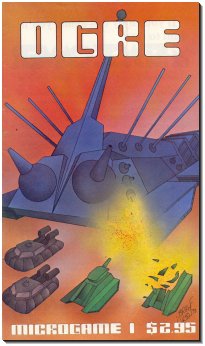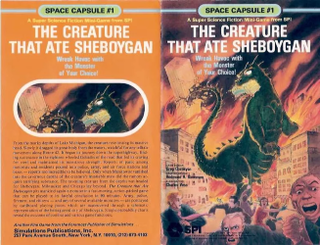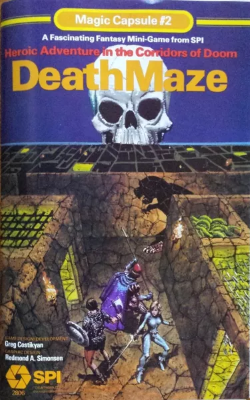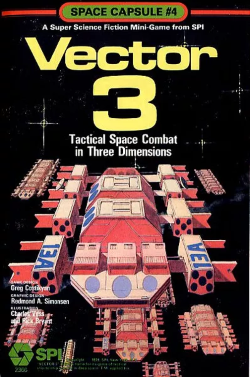
StarGate is a science fiction board game published by Simulations Publications, Inc. (SPI) in 1979 in which players wage combat via spaceships.

StarGate is a science fiction board game published by Simulations Publications, Inc. (SPI) in 1979 in which players wage combat via spaceships.
StarGate is a microgame for 2-players, with one player controlling the alien Virunians, and the other player controlling the Coalition, an alliance of several races.
The game box contains: [1]
Each parallel column of hexes is on a different plane than the adjacent columns. Ships have four options for navigation: [1]
There are two types of combat: [1]
The Coalition needs to destroy six Virunian ships. The Virunians need to destroy eight Coalition ships. Whoever reaches their goal first wins the game. [1]
In the late 1970s, Metagaming Concepts pioneered the MicroGame packaged into a ziplock bag or small flat box. The games sold well, and in 1979, SPI decided to follow suit, [1] publishing a number of "Capsule" games in various genres, including four science fiction-themed "Space Capsule" games. [1] "Space Capsule #2", titled StarGate, was designed by John H. Butterfield, with graphic design by Redmond A. Simonsen and illustrations by Charles Vess and Rick Bryant. [2] SPI released it in March 1979, and it proved very popular, staying in SPI's Top Ten Bestseller list for the next year. [3]
In Issue 24 of The Space Gamer , Mark Watson compared StarGate to microgames by Metagaming Concepts. Although he found StarGate's components to be better, he thought that Metagaming's products "tend to be more interesting." Watson also found that although the various types of movement in Stargate were interesting, "the game soon becomes tedious." However, with the addition of some self-made optional rules, Watson thought the game was much improved, noting that "With such twisted tactics [...] StarGate becomes a fairly interesting game." He concluded that with those rules in place, "StarGate is definitely in a class by itself, certainly worth playing, and undoubtedly worth its current price". [1]
In the October 1980 issue of Fantastic , game designer Greg Costikyan wrote "Star Gate is very chess-like, in that each ship moves in a particular manner. Not a bad little game, on the whole." [4]
In Issue 27 of Simulacrum, Brian Train noted, "This game is an interesting exercise in asymmetry. The Virunians enter the game as a random mixed bag of ship components that must be assembled as Tri-Ships to be fully effective, while the Coalition ships are individually weaker." [5]

OGRE is a science fiction board wargame designed by the American game designer Steve Jackson and published by Metagaming Concepts in 1977 as the first microgame in its MicroGame line. When Steve Jackson left Metagaming to form his own company, he took the rights to OGRE with him, and all subsequent editions have been produced by Steve Jackson Games (SJG).

G.E.V. is a science fiction board wargame that simulates combat in the near future between supertanks and other futuristic weaponry. The game was designed by American game designer Steve Jackson as a sequel to his Ogre board game when he was working for Metagaming Concepts. When Jackson left Metagaming to form his own company, he took the rights to both G.E.V. and Ogre with him, and all subsequent editions have been produced by Steve Jackson Games.

Hitler's War is a strategic level World War II war game for 2 or 3 players, first published by Metagaming Concepts in 1981, and then by Avalon Hill in 1984.

The Creature That Ate Sheboygan is a science fiction board game released in 1979 by Simulations Publications (SPI). The game received good reviews and won an industry award.

Deathmaze is a fantasy board game published by Simulations Publications (SPI) in January 1980 that falls into the general category of dungeon crawls, more specifically, dungeon games in which players enter a dungeon, massacre the dungeon dwellers and steal their treasures.

WarpWar is a science fiction board wargame published by Metagaming Concepts in 1977 that simulates interstellar combat. It was the fourth in Metagaming's MicroGame series.

Outreach, subtitled "The Conquest of the Galaxy, 3000 AD", is a science fiction board wargame published by SPI in 1976 that simulates galactic empire building.

Chitin: I is a science fiction microgame published by Metagaming Concepts in 1977 in which bands of intelligent insects vie for resources.

Swords & Sorcery, subtitled "Quest and Conquest in the Age of Magic", is a fantasy-themed board wargame published by Simulations Publications, Inc. (SPI) in 1978.

Annihilator & One World are two board wargames released in one package by Metagaming Concepts in 1979 as the 14th addition to its MicroGame line.

Hot Spot is a science fiction board wargame published by Metagaming Concepts in 1979 that simulates the battle for possession of a molten planet.

Vector 3 is a science fiction combat microgame published by Simulations Publications, Inc. (SPI) in 1979.

Robots! is a microgame published by Task Force Games in 1980 in which players fight each other using combat robots.

Spellbinder is a fantasy microgame published by Task Force Games in 1980 in which wizards compete to conquer the central castle.

Titan Strike!, subtitled "Battle for the Moon of Saturn," is a science fiction board wargame published by Simulations Publications, Inc. (SPI) in 1979 that is set on Titan, one of Saturn's moons.

Holy War is a science fiction board wargame published by Metagaming Concepts in 1979 in which two groups battle each other inside a pocket universe.

Ice War is a board wargame published by Metagaming Concepts in 1978 that hypothesizes a Eurasian attack against American oilfields in Alaska.

Invasion of the Air-eaters is a science fiction near-future board wargame published by Metagaming Concepts in 1979 in which aliens invaders attempt to replace the oxygen in Earth's atmosphere with sulfur dioxide.

Ram Speed, subtitled "Naval Warfare in the Bronze Age", is a two-player microgame published by Metagaming Concepts in 1980 that simulates naval combat between galleys in the Mediterranean during the Bronze Age when the preferred method of attack was ramming a ship.

Dimension Demons is a science fiction board wargame published by Metagaming Concepts in 1981 as part of its MicroGame line.